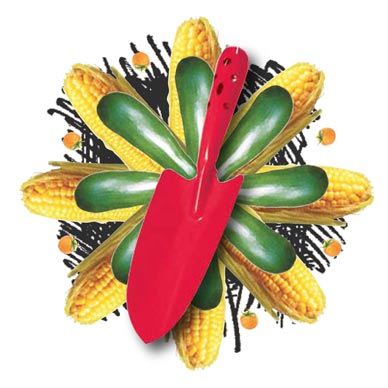
This monthly feature was conceived by writer and Nation editorial board member Walter Mosley as a kind of do-it-yourself opinion and action device. Most often “Ten Things” will offer a brief list of recommendations for accomplishing a desired political or social end, sometimes bringing to light something generally unknown. The purpose of the feature is to go to the heart of issues in a stripped-down, active and informed way. After getting our visiting expert–or everyday citizen–to construct the list, we will interview that person and post a brief online version of “Ten Things,” with links to relevant websites, books or other information. Readers who wish to propose ideas for “Ten Things” should e-mail us at [email protected] or use the e-form at the bottom of this page.
Spiraling food prices and concerns over where food comes from have consumers looking for alternatives to what’s in their supermarket produce bins. Community gardens help people band together to gain control of their own food. Rebecca Hart, an avid Nation reader and Portland, Oregon-area resident, has spent twenty years acquiring the expertise in horticulture to become a certified master gardener. Here are her suggestions for starting a community garden in your neighborhood.
1
Gather like-minded people and organize into a group. When the plot is located and you are ready to begin, apportion and delegate tasks. For tips on organizing a garden community, writing a compact for the group, formulating rules, allocating plots and so on, download the “Community Garden Start-Up Guide” from the University of California, Davis, website, which features advice and tips on creating flexible contracts. Go to Growfriend for more advice on starting up.
2
Locate suitable land with access to water and electricity. You’ll need fencing to keep out four-legged marauders. Vacant lots, schoolyards, retirement homes and churchyards are potential sites. Get permission from property owners.
3
Plan and design your garden carefully. It should have full sun for a minimum of six to eight hours a day. Consider how much land will be needed to give each family ample space for its own plot. Go to the American Community Garden Association to learn more. When laying out plots be sure to leave enough space for paths for walking and trundling wheelbarrows or carts. Remember: many gardens can be grown in less than six months; typically a garden calendar runs from May, after last frost when soil has dried out from spring rains, through October, or first killing frost. Click here to find out your climate by state.
Popular
"swipe left below to view more authors"Swipe →
4
Explain clearly to your group that it takes hard work to grow plants successfully and make sure everyone commits to sharing the labor. Inventory the skills of members and ask neighborhood gardeners to share their experience. For good basic information on plants, see websites of groups like the National Gardening Association.
5
Decide whether your garden will be organic, natural or “anything goes.” Incorporate into your contract the rules governing the type of garden you have chosen. If you have an on-site compost pile, plan to educate gardeners about the differences between carbon- and nitrogen-based compost, and also about what does not go into the compost. For one of the best discussions on the role of bacteria-enriched compost, see Gardening at the Dragon’s Gate by Wendy Johnson.
6
Barter where you can to cut expenses. If you need a toolshed built, for example, trade produce for carpentry skills. Scour yard sales for cheap implements. If you have to raise money for fencing, building materials or other items, create a fundraising appeal tailored to the community. Check out websites like Craigslist for garden supplies and tools.
7
Assemble tools and supplies: hoses, couplings, sprinklers, watering devices, wheelbarrows. New soil is less expensive if purchased by the truckload. Decide which tools and supplies are for communal use.
8
Write down your garden’s goals and record the progress in a garden journal. Set up a website. Tweet and blog your successes! Spread the word to local media outlets. Ask farmers at your local farmers’ market for expert advice on problems you’re having with your crop. Chances are pretty good that your problem is not unique and that you will find a solution. Click here if you live in an urban area.
9
Share your produce with neighbors who don’t have the time or the means to grow a garden. Encourage them to join you next season. According to AmpleHarvest, more than 36 million Americans (12 percent of the population) are hungry and rely on food pantries to help sustain their families. For rules on donating grown or gleaned foods, go the the USDA website.
10
Get to work! Even if next spring is the soonest you can begin, now is the time to plan. In some cases, grants are available for getting a garden started or for taking gardens to another level. Go to Kids Gardening to apply for funds for 2010.
CONCEIVED by WALTER MOSLEY with research by Rae Gomes
[dsl:form ctype=”tent”]


